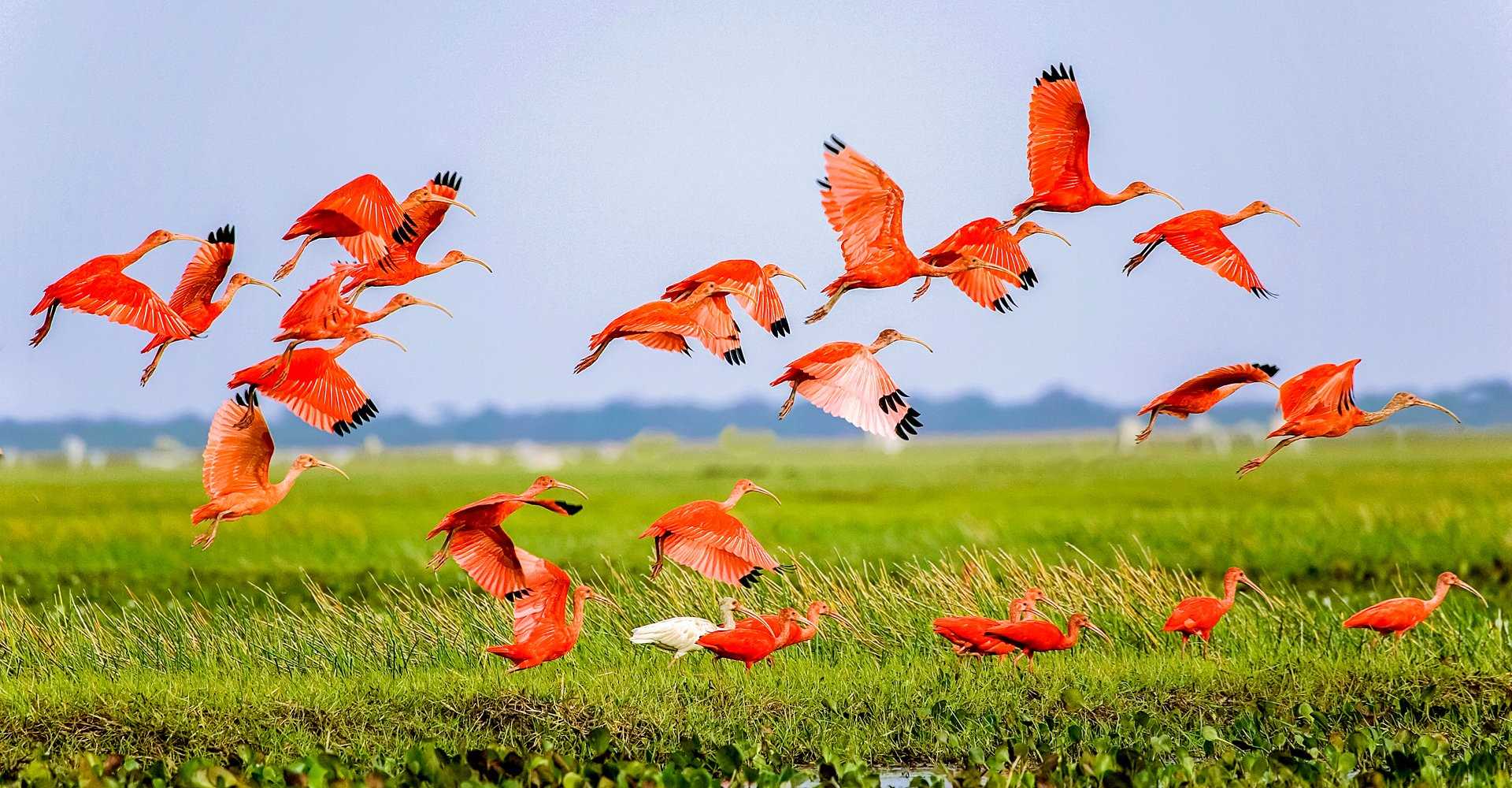With a whopping 3,436 species, South America is home to the highest diversity of birds in the world. According to Lindblad Expeditions Naturalist Mike Greenfelder, it is, “without a doubt the Bird Continent.” The rainforests of the mainland, some 15,800 miles of coastline, the tropical islands, the windswept Patagonian steppe, and the Andes mountain range converge to create an immensely broad range of habitats for the local avifauna. From enormous seabirds to thumb-sized hummingbirds and on to parrots and penguins, these 10 standout South American species deserve a spot on every birder's list. Get Inspired by Photos, Videos, Webinars, Stories, and Exclusive Offers. Sign Up
The Scarlet Ibis
Each day, as dusk nears at Caroni Swamp on Trinidad’s west coast, hundreds of scarlet ibises—which get their brilliant color from a diet of crabs—return to the mangrove trees to roost. “You’re looking at this deep green wall of trees as the sun is setting, and in start flying the most spectacularly vibrant, scarlet-red flocks of birds,” Greenfelder explained. They fill the mangroves so densely that, from a distance, the trees appear to be in full bloom with flowers. It’s a one-of-a-kind wildlife spectacle even non-birders will get a thrill from.

The Channel-billed Toucan
An icon of tropical South America, channel-billed toucans are never hard to spot—though you’ll likely hear their frog-like calls first, says Greenfelder, a croak that distinguishes them from other screeching subspecies. “I think because they’re so gaudy, they like to perch in the open and show off, especially that shiny black and pastel-colored beak.” These sleek attention seekers are often spotted along the Essequibo River in Guyana, and they’re an important part of the forests’ ecosystem because their fruit-filled diet helps to disperse seeds.

The Black-browed Albatross
In the Chilean fjords and Argentinian coast, these majestic seabirds are constantly spotted gliding gracefully above the ship, buoyed by their six-to-eight-foot wingspans. Their name comes from delicate, black eyebrow feathers that look “like they’ve painted themselves with mascara,” as Greenfelder describes. A monogamous species, black-browed albatross breed in the Falklands, with particularly impressive courtship rituals. “They do this incredibly intricate dance; they preen each other. It’s stunningly beautiful to watch and pretty darn romantic for a couple of birds.”

The Burrowing Parrot
Also called the burrowing parakeet, burrowing parrots are native to Argentina and Chile. The world's largest colony lives in the seaside village of Balneario el Cóndor, Argentina, or “La Boca” to locals. Here, thousands of feathered residents have turned the sandstone cliff banks into multi-story condos for nesting. Usually in pairs, their plumage can be subtle greens, blues and yellows, but when they take off to fly, you’ll get a peek at their bright red bellies.

The Magellanic Penguin
During their breeding season, magellanic penguins gather in colonies of hundreds of thousands in many sites across coastal Patagonia like Tierra del Fuego, Puerto Madryn in Peninsula Valdés, and Rupert Islet in the Strait of Magellan. Though these black-and-white-banded, burrowing seabirds may come across as out of place in these thorny grasslands, the feeling doesn’t appear to be mutual—they’ll often waddle about their business without paying much mind to human observers.

The Lesser Rhea
Out on the Patagonian steppe, these giant, flightless birds often catch visitors by surprise, Greenfelder says. “People think, ‘Why is there an ostrich here?’” Standing at about five feet tall, lesser rheas do look and act like ostriches. They can be shy, but in many places they’re unafraid of humans, making for great photo opportunities. And the striped chicks are equally fun to spot. Interestingly, various hens will lay their eggs in the same nest and leave the males in charge of raising them, so they’ll end up with a big gaggle of chicks.

The Andean Condor
Another iconic South American species, the Andean condor’s significance dates back to the Incas, who considered the bird sacred. Weighing up to 33 pounds with a wingspan averaging 10 feet, they’re easy to spot soaring above the Andes and adjacent Pacific coasts. They’re also one of the world's longest-living birds, with lifespans topping 70 years on record. These opportunist scavengers are often seen in the Chilean fjords or at Argentina’s Staten Island—especially if there’s a dead marine mammal, when they’ll congregate by the dozens to feed.

The Masked Booby
When visiting the Fernando de Noronha archipelago in Brazil, masked boobies will often come along for the ride because they’ve learned the ship scares flying fish up out of the water. “You can stand on the bow or the Bridge wing and the boobies will use the wind coming off the ship to fly, nearly within touching distance,” Greenfelder recalls. They’ll see a flying fish, honk like they’re calling dibs, and then plunge to catch it—just one of many incredible opportunities to encounter during a day at sea.

The South American Goose
Small and plump, with a barred pattern of feathers, solid russet head, and crayon-orange legs, this South American goose is quite stunning. They’ve historically nested by the thousands in Tierra del Fuego and southern Patagonia, but their numbers have decreased dramatically. Only about 1,000 remain in all of Argentina and Chile. These days, they’re more common to encounter in the Falklands, wandering in meadows with very little fear of onlookers.








